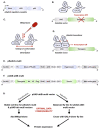An Adapted GeneSwitch Toolkit for Comparable Cellular and Animal Models: A Proof of Concept in Modeling Charcot-Marie-Tooth Neuropathy
- PMID: 38003325
- PMCID: PMC10670994
- DOI: 10.3390/ijms242216138
An Adapted GeneSwitch Toolkit for Comparable Cellular and Animal Models: A Proof of Concept in Modeling Charcot-Marie-Tooth Neuropathy
Abstract
Investigating the impact of disease-causing mutations, their affected pathways, and/or potential therapeutic strategies using disease modeling often requires the generation of different in vivo and in cellulo models. To date, several approaches have been established to induce transgene expression in a controlled manner in different model systems. Several rounds of subcloning are, however, required, depending on the model organism used, thus bringing labor-intensive experiments into the technical approach and analysis comparison. The GeneSwitch™ technology is an adapted version of the classical UAS-GAL4 inducible system, allowing the spatial and temporal modulation of transgene expression. It consists of three components: a plasmid encoding for the chimeric regulatory pSwitch protein, Mifepristone as an inducer, and an inducible plasmid. While the pSwitch-containing first plasmid can be used both in vivo and in cellulo, the inducible second plasmid can only be used in cellulo. This requires a specific subcloning strategy of the inducible plasmid tailored to the model organism used. To avoid this step and unify gene expression in the transgenic models generated, we replaced the backbone vector with standard pUAS-attB plasmid for both plasmids containing either the chimeric GeneSwitch™ cDNA sequence or the transgene cDNA sequence. We optimized this adapted system to regulate transgene expression in several mammalian cell lines. Moreover, we took advantage of this new system to generate unified cellular and fruit fly models for YARS1-induced Charco-Marie-Tooth neuropathy (CMT). These new models displayed the expected CMT-like phenotypes. In the N2a neuroblastoma cells expressing YARS1 transgenes, we observed the typical "teardrop" distribution of the synthetase that was perturbed when expressing the YARS1CMT mutation. In flies, the ubiquitous expression of YARS1CMT induced dose-dependent developmental lethality and pan-neuronal expression caused locomotor deficit, while expression of the wild-type allele was harmless. Our proof-of-concept disease modeling studies support the efficacy of the adapted transgenesis system as a powerful tool allowing the design of studies with optimal data comparability.
Keywords: Charcot–Marie–Tooth neuropathy; Drosophila melanogaster; GeneSwitch™; aminoacyl tRNA-synthetase; disease modelling.
Conflict of interest statement
The authors declare no conflict of interest.
Figures




Similar articles
-
Tyrosyl-tRNA synthetase has a noncanonical function in actin bundling.Nat Commun. 2023 Mar 8;14(1):999. doi: 10.1038/s41467-023-35908-3. Nat Commun. 2023. PMID: 36890170 Free PMC article.
-
Drosophila Models for Charcot-Marie-Tooth Neuropathy Related to Aminoacyl-tRNA Synthetases.Genes (Basel). 2021 Sep 27;12(10):1519. doi: 10.3390/genes12101519. Genes (Basel). 2021. PMID: 34680913 Free PMC article. Review.
-
Boosting BDNF in muscle rescues impaired axonal transport in a mouse model of DI-CMTC peripheral neuropathy.Neurobiol Dis. 2024 Jun 1;195:106501. doi: 10.1016/j.nbd.2024.106501. Epub 2024 Apr 6. Neurobiol Dis. 2024. PMID: 38583640 Free PMC article.
-
Dominant mutations in the tyrosyl-tRNA synthetase gene recapitulate in Drosophila features of human Charcot-Marie-Tooth neuropathy.Proc Natl Acad Sci U S A. 2009 Jul 14;106(28):11782-7. doi: 10.1073/pnas.0905339106. Epub 2009 Jun 26. Proc Natl Acad Sci U S A. 2009. PMID: 19561293 Free PMC article.
-
[Animal models of Charcot-Marie-Tooth disease and their relevance for understanding the disease in humans].Rev Neurol (Paris). 2013 Dec;169(12):971-7. doi: 10.1016/j.neurol.2013.07.027. Epub 2013 Nov 13. Rev Neurol (Paris). 2013. PMID: 24238786 Review. French.
References
-
- Nover L., Hightower L. Heat shock and development. Introduction. Results Probl. Cell Differ. 1991;17:1–4. - PubMed
MeSH terms
Substances
Grants and funding
LinkOut - more resources
Full Text Sources
Medical
Molecular Biology Databases

